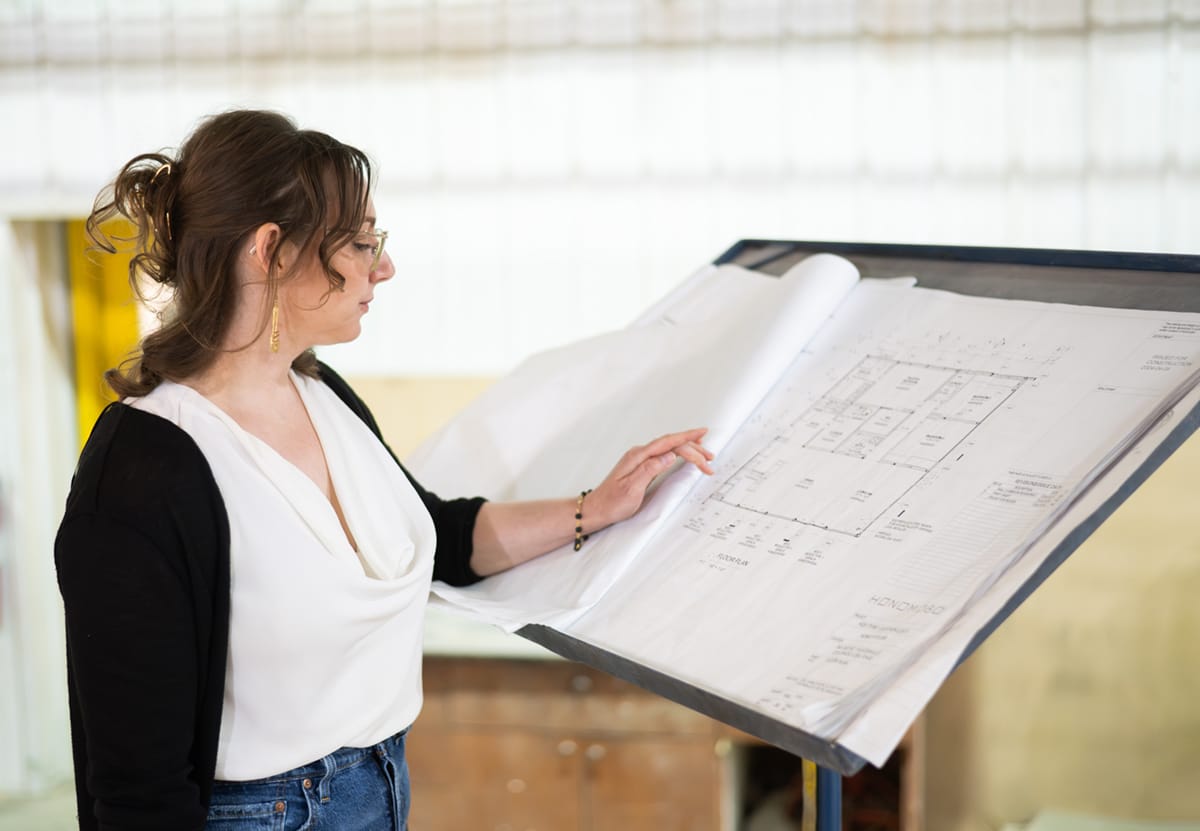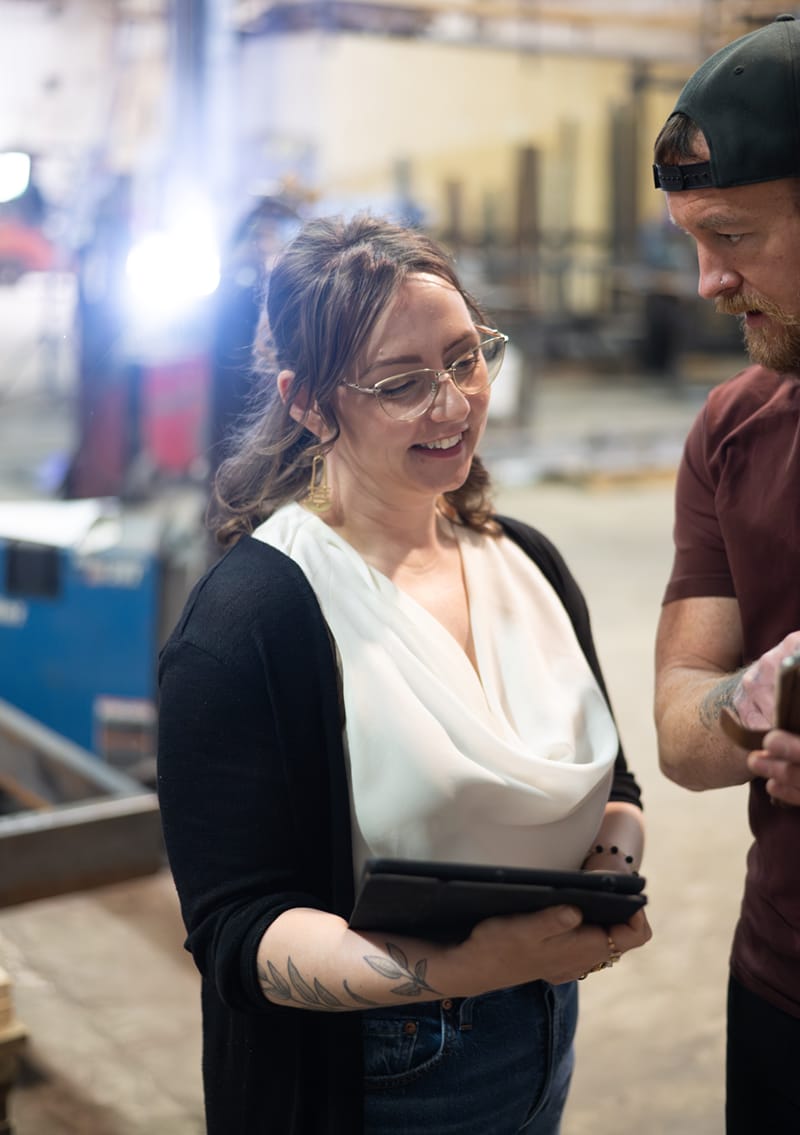Jamie Metzger: From Construction to Apparel and Back Again
Growing up in a blue-collar city like Edmonton, Alberta, Canada, it’s no surprise that Jamie Metzger spent some time working labour jobs on construction sites. It’s one of the most common summer jobs in the city.
But that’s probably the last predictable thing about this particular story.
That’s because Jamie moved away, got a design degree, spent some time in the apparel industry, and then moved back to Edmonton to eventually be an instrumental force in high-end single-family modular home design and manufacture. It’s not exactly what you would think of as a typical path to a construction career.

Jamie Metzger currently serves as Honomobo's director of design.
Designing a Solid Foundation
Long before Metzger landed in her current role, she moved to Toronto and completed a very intense technical design degree at Ryerson University.
After graduation, she spent some time in the apparel industry, which is about as far removed from construction as you can get.
However, it gave her experience in something that most on-site construction companies don’t do too much of. Manufacturing. More specifically, Jamie learned to create product lines, design with manufacturing in mind, and standardize concepts so they could be replicated easily.
A Return to Edmonton
After some time away from her home city, Jamie moved back to Edmonton and once again found herself back in the construction world.
This time, she started working for a custom home builder who specialized in infill housing, using her existing design skills and learning much of the homebuilding expertise she needed on the job.
Evolving to Offsite Building
Like so many companies in the modular building world, Honomobo evolved almost organically out of a need for innovative building solutions.
In this case, the company Jamie worked for recognized that there was a growing market for garage suites or ADUs. They soon realized that they could design them as modular structures, build them off-site and control and speed up the process significantly, although it would be a while before they developed their standard design range.
What they didn’t expect was the surge in demand for their high-end single-family designs for primary and secondary residences. Or that their modular business division would be in demand not only in Canada but throughout the United States, too.

In fact, once the team began designing and building their sleek, modern, energy-efficient homes, it quickly overtook even their established custom-building business.
Committing to Modular
In 2019, when Jamie joined the team full-time, they realized that the future of their business lay in modular building. They wound down the on-site construction division of the business, and the Honomobo brand was born.
Jamie took on the role of design director, and since then, she’s been using not only her technical knowledge of design and permitting in construction but also her manufacturing knowledge to help grow and develop winning designs and the team to build them.
A Varied Work Week
Like many people who have been involved in creating a forward-thinking, boundary-pushing company like Honomobo, Jamie Metzger has her finger in more than one pie.
As design director, she oversees the full design team process and assists in new product design, prototyping, permitting and state certifications. But her role involves more than just managing a team of talented designers.
Many days, you will find Jamie on the factory floor, working directly with the people who turn those designs into tangible products. Sometimes, she’s even consulting with on-site construction crews about the planning and execution of the installation process.
It’s this kind of flexibility and the ability to connect with people across the whole modular building spectrum that has been part of Jamie’s success in the industry.
Unique Challenges and Opportunities
Working in two different countries, spread out over such a vast geographical area, comes with some unique challenges.
One is that as a company that manufactures high-end custom modular homes for clients throughout Canada and the United States, every new job site location brings unique permitting, approvals and even financing challenges.
Another is changing the perception of modular homes. However, in this case, Honomobo’s ultra-modern designs usually speak for themselves.
One challenge the company does not have that many other Edmonton home builders battle every year is the weather. Even in a city that has six months of winter, Honomobo can plan, control, and execute multiple projects all year round.
Embracing Innovation and Change
Perhaps the most surprising thing about Jamie Metzger is how well she’s made the transition from one of the world’s oldest manufacturing industries to one of the newest.
Whether it is working with remote and hybrid teams in Canada and the United States or fitting R&D into their already packed production schedule, Jamie Metzger and the team at Honomobo are surprisingly comfortable being ahead of the curve.
Digital technology (including collaborative drawing and project management tools) helps. Still, it’s the Honomobo team’s willingness to embrace them, along with new systems, innovative ideas and cutting-edge design, which is the real secret.
Or, as Jamie puts it, “Design is a process for solving problems. No matter how unexpected, there is always a solution.”


About the Author: Tamara Aspeling is a published author and freelance writer who specializes in construction and writes for print and web. She’s also a trained estimator and project manager with over 20 years of industry experience. You can reach her at www.theconstructionwriter.ca or words@theconstructionwriter.ca.
More from Modular Advantage
Resia: Breaking All the Rules
Resia Manufacturing, a division of U.S.-based Resia, is now offering prefabricated bathroom and kitchen components to industry partners. Its hybrid fabrication facility produces more precise bathroom and kitchen components (modules) faster and at lower cost than traditional construction. Here’s how Resia Manufacturing does it.
How LINQ Modular Innovates to Bring Modular To The Market in the UAE and Beyond
LINQ Modular, with an office and three manufacturing facilities in Dubai, is a modular firm based in United Arab Emirates. The company is on a mission: to break open the housing and construction markets in the Gulf Cooperation Council (GCC) area with modular.
ModMax: Redefining Modular Construction with Confidence and Precision
ModMax was born out of frustration—frustration with five persistent pain points in modular construction: Permitting bottlenecks. Production delays. Rigid designs. Disconnect between “the office” and the field. Lack of transparency and communication.
LifeArk: Disaster-Resilient Housing from Recycled Plastic and 100-year-old Technology
Wee compares LifeArk’s housing units to Yeti coolers, as they are built similarly. Each component takes 15 to 20 minutes to manufacture, has an R-value of 40, and includes molded slots and chases for wiring, plumbing, fire sprinklers, and other utilities.
Building the Future of Modular Edge Infrastructure
The edge data center market is expanding rapidly, driven by the surge in AI workloads, IoT adoption, and the need for localized compute power. In these environments, sustainability, scalability, and reliability are non-negotiable. Cooling is among the most complex challenges for operators—and one of the most decisive factors in long-term success.
Accelerating Light-Gauge Steel Construction: A Semi-Automated Digital Workflow for Off-Site Projects
For construction professionals, the message is clear. By adopting semi-automation and digitalization, companies can deliver projects faster, more accurately, and more profitably, while also building stronger collaboration across teams. The approach is not about replacing people with machines, but about empowering people with better tools and processes.
Why Modular Data Centers Are Gaining Momentum
Artificial intelligence, high-performance computing, and edge applications push the limits of traditional “stick-built” data centers. They take years build, often struggle with high density workloads, and aren’t optimized for deployments near end users. Modular data center platforms are purpose-built to address these challenges, offering flexibility and scalability to adapt to evolving technologies, while opening new opportunities for the modular construction industry.
Supply Chain Innovation in Action: 5 Habits Every Modular Leader Should Practice
By applying these principles to supply chain practices — collaborative planning, strategic procurement, scenario modeling, digital tools, and transparent forecasting — construction leaders can build value chains that are not just efficient and agile, but truly innovative.
Exploring the Role of Modular Integrated Construction (MiC) in Advancing Circular City Principles – A Survey of Stakeholder Perspectives
The survey findings highlight the significant potential of Modular integrated Construction (MiC) in advancing the development of circular cities. By reducing costs, accelerating construction timelines, and minimizing waste generation, MiC offers a promising approach to sustainable urban development.
The Use of MS POLYMER™-Based Sealants and Adhesives in Modular Building
These products combine flexibility and elastic recovery with excellent adhesion to different substrates and have already shown their usefulness in traditional construction. Now it’s time for them to be put to use in the modular construction industry.










